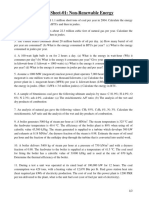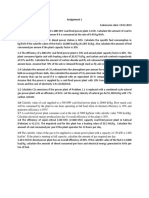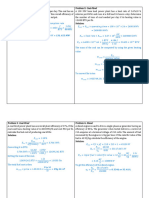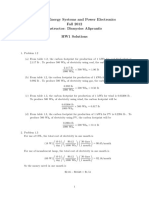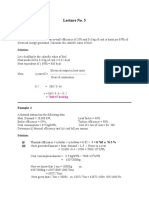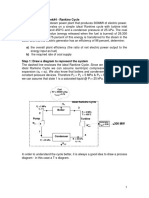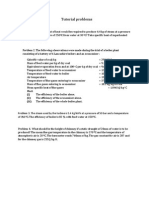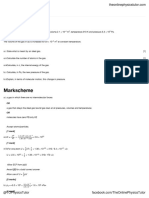TECHNOLOGIES FOR CLEAN AND
RENEWABLE ENERGY PRODUCTION
TUTORIAL 1
DR. PRASENJIT MONDAL
CHEMICAL ENGINEERING
1
�Problem 1.
The proximate analysis of a coal sample and its heating value are as follows:
Moisture 2.9%, Volatile Matter 29.4%, Fixed Carbon 58%, Ash 9.7% and gross
calorific value 7650 Kcal/Kg.
Calculate proximate analysis and calorific value on
a) Moisture free basis
b) Dry ash free basis
2
� Solution
As received Moist free basis Dry ash free basis
basis
M 2.9 - -
VM 29.4 29.4*100/(100-2.9) = 29.4*100/(100-12.6) =
30.28 33.64
FC 58 58*100/(100-2.9) = 59.73 58*100/(100-12.6) = 66.36
Ash 9.7 9.7*100/(100-2.9) = 9.99 -
Calorific value 32023 32979 36640
(KJ/Kg)
3
�Problem 2. During a boiler trial the coal analysis on mass basis was reported as
C: 62.4 (%), H: 4.2 %, O: 4.5 %, N:0.4 %, S: 0.2%, Moisture: 14.4% and Ash: 13.9%.
Assume average molecular weight of ash is 56.
Determine the molecular formula of the coal and the heating value on as received
basis and dry basis using the following
HHV in MJ/Kg = 0.3516*C + 1.16225*H - 0.1109*O + 0.0628*N + 0.10465*S
LHV in MJ/kg = HHV (in MJ/kg ) – 0.0244 (W -9H)
where W is % of moisture and H is % of H
4
�Solution Assume total mass of sample = 100Kg
As Mass of Mol. Moles Dry
received element Wt. of basis
basis (g) element
%C 62.4 62.4 12 5.2 72.89
%H 4.2 4.2 1 4.2 4.91
%O 4.5 4.5 16 0.28 5.26
%N 0.4 0.4 14 0.028 0.47
%S 0.2 0.2 32 0.0062 0.23
% Ash 13.9 13.9 56 0.248 16.24
% 14.4 14.4 18 Total dry wt.
molecular formula: 0.8= 85.6 Kg -
Moisture Molecular formula C5.2H4.2O0.28N0.028S0.0062A0.248(H2O)0.8
5
� Heating value of as received sample
HHV = 0.3516*C + 1.6225*H – 0.1109*O + 0.0628N + 0.10465*S
HHV = (0.3516*62.4) + (1.6225*4.2) – (0.1109*4.5) + (0.0628*0.4) + (0.10465*0.2)
HHV = 28.3MJ/Kg
LHV = HHV – 0.0244(W + 9H) MJ/kg
LHV = 28.3 – 0.0244(14.4 + 9*4.2)
LHV = 27.02 MJ/Kg
6
� Heating value on dry basis
HHV in MJ/Kg = 0.3516*C + 1.16225*H - 0.1109*O + 0.0628*N + 0.10465*S
HHV = (0.3516*72.89) + (1.16225*4.91) – (0.1109*5.26) + (0.0628*0.47) + 0.10465*0.23)
HHV = 30.81 MJ/Kg
LHV = HHV – 0.0244(W+9H)
W=0
H = 4.9
LHV = 30.81 – 0.0244(9*4.91)
LHV = 29.73 MJ/Kg
7
�Problem 3.
To determine the water equivalent of a bomb calorimeter 1.1651 gram benzoic acid
sample (HHV 6318 cal/g) was used. The experiment produced a net corrected
temperature rise of 3.077o C. The acid titration required 11.9 ml of standard alkali
and 8 cm of Parr 45C10 nickel-chromium fuse wire was consumed in the firing.
Determine the water equivalent of the bomb calorimeter.
8
�Solution
Given data
H = 6318 cal/gram Therefore,
M = 1.1651 gram E1 = (11.9 ml)(1 cal/ml) = 11.9 cal;
C1 = 11.9 ml E2 = (13.7)(C2)(m) calories = 0 as C2 is 0
C2 = 0 E3 = =(2.3)(C3) = (2.3 cal/cm) (8 cm) = 18.4 cal
C3 = 8 cm
T = 3.077o C
We know that
W= {(6318)(1.1651)+11.9+18.4}/3.077
W = (H*M + E1 + E2 + E3)/ T
= 2402.1 cal per deg C
9
�Problem 4.
For a coal fired utility boiler, the temperature of high pressure steam would be about 540
degrees C and Tcold, the cooling tower water temperature, would be about 20 degrees C.
Calculate the Carnot efficiency of the power plant.
Solution:
Step 1
Convert the high and low temperatures from Celsius to Kelvin:
Thot = 540oC + 273 = 813K,
Tcold = 20oC + 273 = 293K,
10
�Step 2
Determine the efficiency using the Carnot efficiency formula:
η= [1−Tcold/Thot] ×100%
η= [1−293K/813K] ×100%
=64%
11
�Problem 5.
Conventional coal fired power plant costs $1,200 per kW to construct and have an
efficiency of 34%. Advanced plants use the clean burning Integrated Coal
Gasification Combined Cycle (IGCC) in which the coal is subjected to heat and
pressure to gasify it while removing sulfur and particulate matter from it. Currently
the construction of IGCC plant costs about $1,400 per kW, but their efficiency is
about 45%. The average heating value of coal is about 2,80,00,000 kJ per ton (that
is, 2,80,00,000 kJ of heat is released when one ton of coal is burned.) If the IGCC
plant is to recover its cost difference from fuel savings in five years, determine what
the cost of coal should be in $ per tonne. Time value of money may be ignored.
12
�Solution:
Here we assume that the economic analysis is based on a payback period where we
do not account for the time value of money.
The construction cost difference is $200 per kW. The amount of electricity, in kWh,
generated in five years, per kW of capacity is equal to the time that the plant is used
times the fraction of its average capacity that is used.
If we assume for the best case to justify the IGCC plant that both plants are operated
at full capacity for five years, the total hours of operation, assuming only one leap
year in five years, will be (24 hours/day)(4*365+366 days) or a total of 43,824 hours.
Thus each kW of capacity will produce a total of 43,824 kWh over the five-year
period.
13
�The amount of coal to produce this energy (from each kW of generating capacity) is
determined by the efficiency of the plant and the heating value of the coal. For the
conventional plant, the total coal use over five years (for each kW of generating
capacity) is
1 kJ 3,600 s
(43,824 kW h)
mcoal
QH
W
kW s hr 16.57 tons
( HV ) coal ( HV ) coal (0.34)
28,000,000 kJ
ton
For the IGCC plant, the total coal use over five years (for each kW of generating capacity) is:
1 kJ 3,600 s
(43,824 kW h )
mcoal
QH
W
kW s hr 12.52 tons
( HV ) coal ( HV ) coal (0.45)
28,000,000 kJ
ton
14
�Thus the IGCC plant will save 16.57 – 12.52 = 4.05 tons over the five year period for each kW
of plant capacity. Since the IGCC plant costs an extra $200 to build, we will be able to pay off
this cost difference in five years if the price of coal is at least $200/(4.05 tons) =$49.37/tonne.
We see that the amount of coal saved is directly proportional to the amount of time the plant
runs. If the plant only produced 75% of the maximum possible kilowatt hours over a give year
period, the coal savings would be only 3.04 tonnes and coal would have to cost about $65.83
to make the IGCC plant pay off in five years.
15
�Thanks…
16




